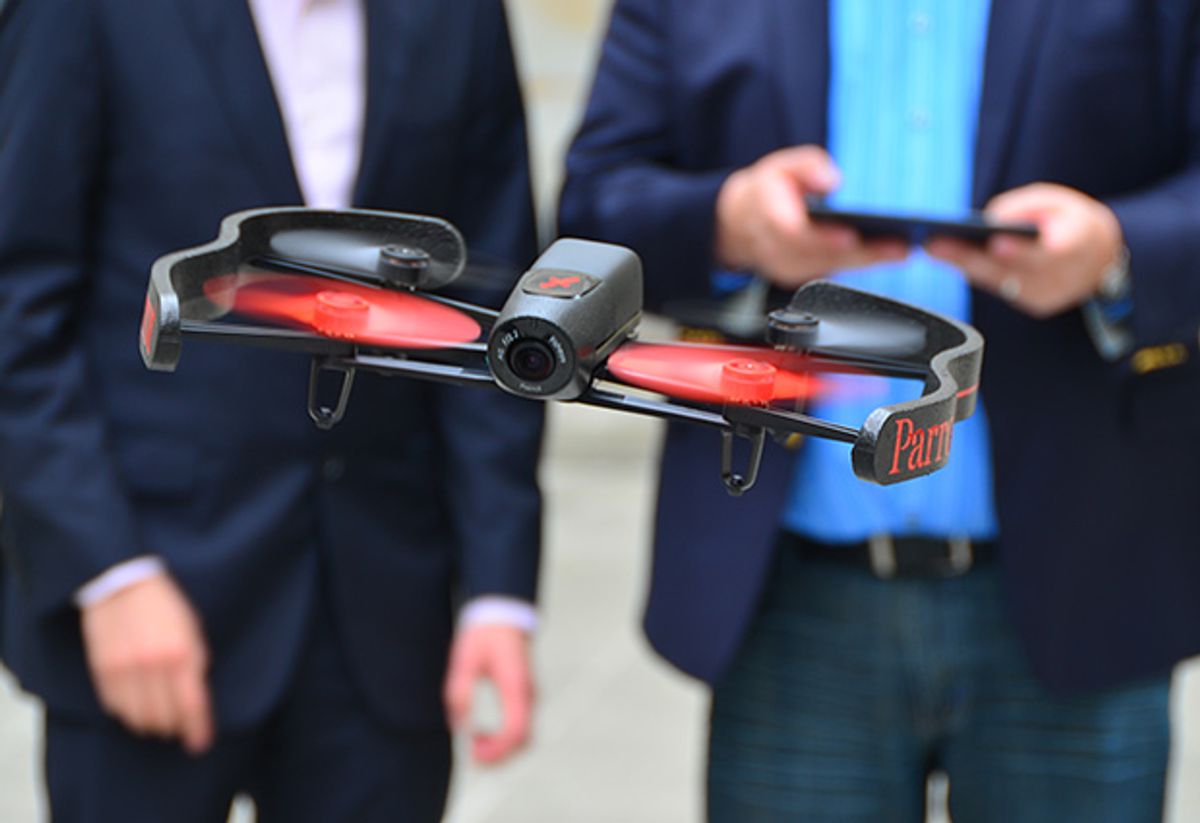Last September, Parrot unveiled its latest AR Drone upgrade, the Power Edition, with longer flying time and new colors, and the company also revealed it was hard at work testing a new GPS autopilot system. Then early this year at CES, Parrot released a brand new quadrotor called the MiniDrone.
That's all really cool and we figured that, okay, it's going to be a while (like, a year) before we see any sort of new flying robot from Parrot. We apparently underestimated Parrot by a lot, because last week, they gave us a look at a completely new drone that includes a bunch of unique features that are totally worth getting excited about.
Here's the official video:
The new Parrot quadrotor is called Bebop, and we have it on good authority that it was not named after the mutant rhino from Teenage Mutant Ninja Turtles. With Bebop, Parrot is focusing very heavily on incredibly awesome, feature-rich video, as evidenced by the gigantic, 14-megapixel camera with fish-eye lens attached to the front part of the drone:
And here's what is interesting about this big camera: the sensor has a field of view of 180 degrees, but when it sends video to the user's phone or tablet, it uses only a smaller subset of the available pixels. In other words, the drone streams video by subsetting a 1920 x 1080 pixel rectangle (about 2 megapixels worth) out of the 14 megapixels that the sensor covers. Why does it do that? To be able to perform two neat tricks:
Digital image stabilization: the drone uses a 3-axis accelerometer, a 3-axis gyroscope, and a 3-axis magnetometer to digitally compensate for movement. If there's some turbulence and the drone rolls a bit, it will adjust the video to compensate, taking advantage of all of the extra pixels that the sensor has available. We saw a demo of this, and it works for both small vibrations and giant movements, including putting the entire drone over through a 360 degree roll while it keeps giving you a stable, right-side up video. It's very impressive, and all done onboard with an integrated GPU.
Digital panning: the drone's camera is fixed, meaning that ordinarily, to look up and down or size to side, you'd have to yaw or tilt the entire drone. Instead, you can pan and tilt the video by just changing the area of the sensor that's being used, such that you can look almost completely up or down or side to side (within 180 degrees) just using the sensor, without the drone moving at all.
In addition to the digital image stabilization, Bebop's camera is completely isolated from the frame and the motors by anti-vibration bumpers, which are the orange things in the image below. The bottom of the drone also gives a good look at the four 2.4/5 GHz ceramic Wi-Fi antennas, the ultrasonic altitude sensor, and the little downward-pointing camera that uses optic flow for stabilization and speed estimation.
The other big news is the new controller that Parrot is (optionally) pairing with the Bebop drone. It's pretty crazy:
The Parrot Skycontroller is essentially a big tablet dock with a dedicated drone interface. Those are honest-to-goodness R/C-style analog control sticks (YAY!) along with a ludicrously powerful 36dBm a/b/g/n/ac directional MIMO quad Wi-Fi antenna that can talk to your drone (and stream video from it) from up to two kilometers away. Oh, and it runs on the same battery pack as the drone does, which is a nice touch.
If it sounds like all of this is just asking to be worked into some sort of immersive drone piloting experience, Parrot is way ahead of you, and they've already got an operational demo of drone control via Oculus Rift:
It's a little bit of a hack, but the really cool part is that head movement when you've got the Rift on syncs up with the digital panning, so you can look around while the drone remains stationary. There's a lot of polishing that needs to be done, but the potential is very exciting.
The bad news in all of this is that the battery life on the BeBop is just 12 minutes, but it's easy to swap the battery packs to keep on flying. We can also report that the drone crashed a whole bunch of times over the course of the demos that we saw, and it emerged unscathed. If you're a terrible pilot, the BeBop has integrated GPS (which also receives Galileo and GLONASS), and can autonomously follow waypoints as well as returning home by itself.
Parrot has not yet announced pricing for Bebop (or for the controller), but they're aiming to be competitive with other drones designed for video capture, without replacing the AR Drone for consumers or hobbyists. Our guess would be somewhere between $600 and $800, although we're of course hoping for more affordable as opposed to less. And we have no idea what the controller is going to retail for, although we desperately want one, and if Parrot opens it up (and they've suggested that it'll be compatible with "most open-source drone control software"), we could see it becoming the control system of choice for any serious drone user.
Whatever it ends up costing, expect the Bebop drone to be up for grabs in time for the holidays.
[ Parrot ]
Evan Ackerman is a senior editor at IEEE Spectrum. Since 2007, he has written over 6,000 articles on robotics and technology. He has a degree in Martian geology and is excellent at playing bagpipes.










